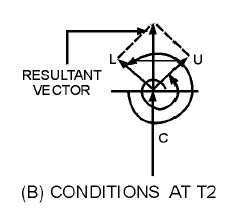1-53
405 degrees. Vector L, representing the lower sideband, rotates at a velocity less than that of either the
carrier or the upper sideband. In 1/8 of a second, vector L completes only 315 degrees, which is 45
degrees short of one complete rotation. At the end of 1/8 of a second, the three vectors have advanced to
the positions shown in view (B).
Figure 1-44B.—Vector diagrams for T1 and T2.
The resultant vector in view (B) is obtained by adding vector U to vector L. Since each sideband has
one-half the amplitude of the carrier, and the two sidebands differ in phase by 90 degrees, the amplitude
of the resultant vector can be computed. This computation (not shown) would show the resultant vector to
have an amplitude that is approximately 70 percent that of the carrier. Thus, at T2 the amplitude of the
modulation envelope is about 1.7 times the amplitude of the carrier. This condition is shown in figure
1-43, view (F).
By a similar procedure, vector diagrams can be constructed for time intervals T3 through T9. This
has been done in figure 1-43, view (E). From these nine individual vector diagrams, the complete
modulation envelope in figure 1-43, view (F), can be constructed.
Notice in particular the vector diagrams for T3 and T7. At T3, all three waves, and therefore all three
vectors, are in phase. The modulation envelope at this instant must, therefore, be equal to twice the
amplitude of the carrier since each sideband frequency has one-half the amplitude of the carrier.
At T7, the two sideband frequencies are in phase with each other but 180 degrees out of phase with
the carrier. This causes the combined sideband voltage to cancel the carrier voltage, and the modulation
envelope becomes 0 at that instant. Note that for the transmitter output to be 0 at T7, both the carrier and
sideband frequencies must be present. If any one of these three frequencies were missing, complete
cancellation would not occur and rf energy would be present in the output.
Although this vector analysis was made for frequencies of 7, 8, and 9 hertz, the same description
could be applied to the frequencies actually present at the output of a transmitter.
Modulation Level of an AM Wave
As stated earlier, the modulating signal can be introduced into any active element of a tube. In
addition to the various arrangements possible within a single stage, the modulating signal can also be
applied to any of the rf stages in the transmitter. For example, the modulating signal could be applied to
the control grid or plate of one of the intermediate power amplifiers.
A modulator circuit is usually placed into one of two categories, high- or low-level modulation.
Circuits are categorized according to the level of the carrier wave at the point in the system where the

